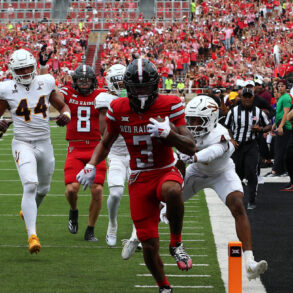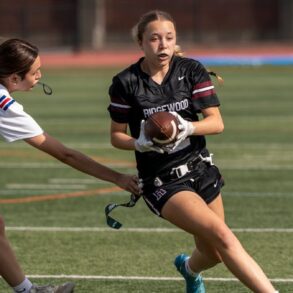The transfer portal has fundamentally reshaped college football. While player movement existed long before its official launch in October 2018, the portal streamlined the process, and recent rule changes have only accelerated the trend, making it even more appealing for athletes to find new opportunities.
More than 4,000 players entered the portal during the 2024-25 cycle, but only a select few will make a major impact. But the most successful transfers don’t just fit in, they change the trajectory of their new programs. Just look at the last three Heisman Trophy winners, all of whom began their careers elsewhere. In fact, six of the past seven Heisman winners were transfers.
Most programs now prioritize adding projected high-impact transfers by targeting experienced players who can contribute immediately and fill glaring needs. Coaches balance recruiting high school prospects with portal additions to accelerate program success, reshaping how teams are built.
From game-breaking quarterbacks to generational two-way stars, here are the 10 most impactful college football transfers of the portal era.
10. Olu Oluwatimi, Michigan
Oluwatimi anchored Michigan’s offensive line after transferring from Virginia (and previously Air Force), bringing experience and leadership to the interior. In 2022, he won both the Rimington and Outland Trophies — becoming the first center in program history to do so — while helping the Wolverines reach the College Football Playoff with another Big Ten title. His presence in the middle helped Michigan win a second consecutive Joe Moore Award.
Verse went from relative unknown to one of the most feared edge rushers in college football. After dominating the FCS level at Albany, Verse made an immediate impact at Florida State, earning back-to-back All-America honors and fueling the Seminoles’ return to national relevance. In two seasons in Tallahassee, he totaled 18 sacks and 30 tackles for loss, showcasing elite burst, power and consistency off the edge. His presence elevated the entire Florida State defense and helped set the tone for the undefeated regular season and ACC title in 2023 — though it ended with a controversial College Football Playoff snub.
8. Jameson Williams, Alabama
Williams ranks as the fourth-highest non-quarterback on this list — and with good reason. After transferring from a crowded Ohio State receiver room, he erupted for a breakout 2021 season at Alabama and seamlessly filled void left by Heisman Trophy winner DeVonta Smith. Williams led the Crimson Tide with 1,572 receiving yards and 15 touchdowns, adding two more scores on kick returns. His game-breaking speed transformed Alabama’s offense, and there is a strong case the Tide might have repeated as national champions if he had not torn his ACL in the second quarter of the title game.
7. Jayden Daniels, LSU
Daniels came a long way from his turbulent exit at Arizona State, where some former teammates openly mocked his departure. In just two seasons at LSU, he transformed into a Heisman Trophy winner and the No. 2 overall pick in the 2024 NFL Draft. Daniels played a central role in LSU’s back-to-back double-digit win seasons under Brian Kelly, even if both ultimately fell short of a playoff berth. He broke multiple NCAA and school records, including the highest single-season passer rating in FBS history (208.0), and became the only player ever to surpass 12,000 passing yards and 3,000 rushing yards in a career. Few transfers have maximized their move like Daniels did.
6. Travis Hunter, Colorado
Travis Hunter stands as one of the most impactful transfers of the portal era and a true two-way force college football had not seen since Charles Woodson in the mid-1990s. After beginning his career at FCS Jackson State under Deion Sanders, Hunter followed his coach to Colorado in 2023. In his second season with the Buffaloes, he won the Heisman Trophy, along with the Bednarik and Biletnikoff Awards — an unprecedented sweep for a player starring on both sides of the ball. He logged an FBS-high 1,483 snaps, including 714 on offense, 748 on defense and 21 on special teams, thriving even in Boulder’s altitude. Hunter led Colorado with 96 catches for 1,258 yards and 15 touchdowns, while also recording a team-best four interceptions and 11 pass breakups.
Williams achieved nearly everything possible during his two years at USC, except a conference title and a College Football Playoff berth. That caveat tempers his status among top transfers of the portal era. After following Lincoln Riley from Oklahoma, Williams delivered a Heisman Trophy-winning campaign in 2022. His off-script playmaking ability set him apart, but he also put up eye-popping numbers: 8,170 passing yards, 72 touchdowns and just 10 interceptions, along with 21 rushing touchdowns. Williams raised the ceiling for USC’s offense, but without the overall team success to match, his legacy as a transfer remains more individual than program-altering.
Downs has already made one of the most substantial impacts of any transfer in the portal era — and he is not done yet. After leading Alabama in tackles as a freshman, Downs transferred to Ohio State and helped transform one of the nation’s best defenses into a championship unit. He played a pivotal role during the Buckeyes’ national title run, making timely game-changing plays and anchoring the secondary with poise well beyond his age.
Walker’s impact at Michigan State only grows more significant with time. In hindsight, the former Wake Forest transfer essentially propped up the Mel Tucker era and played a major role in the $95 million extension that ultimately backfired — even before Tucker was fired for cause. In 2021, Walker earned unanimous All-America honors, won the Doak Walker Award and rushed for 1,636 yards (second nationally) with 18 touchdowns and 6.22 yards per carry. He literally carried the Spartans to 11 wins and a New Year’s Six bowl — their only winning season under Tucker. The program has not recovered since he left.
2. Justin Fields, Ohio State
Fields’ arrival likely spared Ohio State from one or two rough seasons. The Georgia transfer beat out Tate Martell and quickly rose to stardom in Columbus, going 20–2 as a starter with both losses coming in the College Football Playoff (Clemson in 2019 and Alabama in 2020). Fields completed 68.4% of his passes for 5,373 yards, 63 touchdowns and just nine interceptions, while also rushing for 867 yards and 15 scores. He remains the last Buckeyes quarterback to defeat Michigan.
1. Michael Penix Jr., Washington
This might be an unpopular opinion, but Penix deserves more recognition among elite transfer quarterbacks, which is why he is No. 1 on this list. After reuniting with Kalen DeBoer, his former coordinator at Indiana, Penix led Washington to a national championship game appearance at the end of the 2023 season. He topped the nation in passing yards (4,903) and attempts (555), ranked third in touchdowns (36) and finished second in the Heisman Trophy voting. During Penix’s two-year tenure as starter, Washington lost just three games — its fewest in any two-year stretch since the 1991 national championship season.
This post was originally published on this site be sure to check out more of their content.














